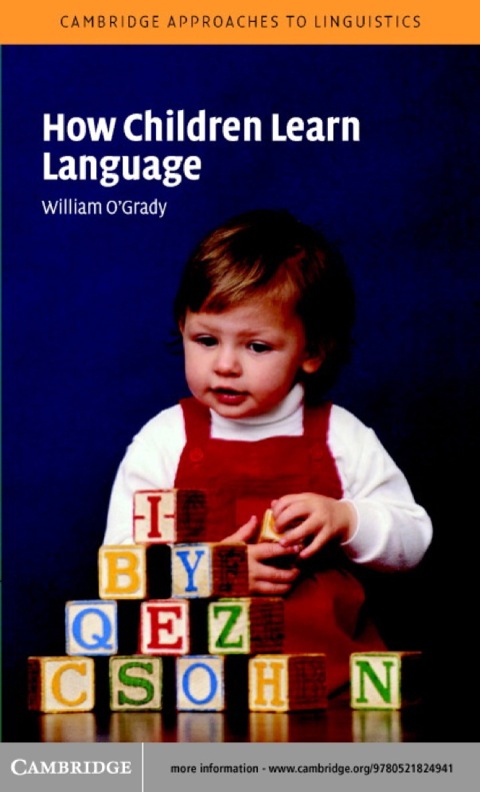Description
Efnisyfirlit
- Half-title
- Series-title
- Title
- Copyright
- Contents
- Acknowledgments
- 1 Small talk
- Sounds, words, and sentences
- Methods 101
- What’s next
- 2 The great word hunt
- 1. Where are the words?
- Two learning styles
- 2. How children find words
- Spotlights
- Making matches
- 3. Learning inflection
- The plural ending-s
- The past tense ending -ed
- Irregular verbs
- Irregular nouns
- How many times do you have to hear me say that?
- 4. Creating words
- Three ways to create words
- 1. Conversion
- 2. Derivation
- 3. Compounding
- I want to scissor it – learning conversion
- It’s crowdy in here – learning derivation
- Let’s go by sky-car – learning compounds
- Compounds and stress
- Compounds and plurals
- Summing up
- 3 What’s the meaning of this?
- 1. First meanings
- Why nouns?
- Noun-lovers and noun-leavers
- 2. Not enough and too much
- If it looks like a duck . . .
- Did you do that on purpose?
- 3. Fast mapping
- 4. Tools of the trade – how children learn nouns
- Using your head (cognitive constraints)
- Help from family and friends (social constraints)
- Lessons from language (linguistic constraints)
- Being exclusive (an organizational constraint)
- 5. Learning verbs
- Bootstrapping
- Some tough verbs
- 6. Learning adjectives
- Sizes
- Colors
- Numbers
- 7. Learning prepositions
- Errors of omission and commission
- 8. Learning pronouns: I and you
- Summing up
- 4 Words all in a row
- 1. Getting started
- Grammar in the cradle?
- Real words and real sentences
- Tracking the growth of sentences
- 2. Pivotal words
- 3. Getting things lined up
- Big rules and little rules
- 4. Missing big pieces
- Caught in the bottleneck
- 5. Missing small pieces
- One by one
- 6. Learning to say “not”
- Is it no or is it not?
- No light verbs
- A negative beginning
- 7. I, me, and my
- 8. Who? What? Where?
- What are you asking about?
- 9. Yes–no questions
- Long moves
- 10. Other constructions
- The arrival of relatives
- Summing up
- 5 What sentences mean
- 1. What a word can do
- How much can children understand in the one-word stage?
- 2. Two is better than one
- How much can children understand in the two-word stage?
- 3. Passive sentences
- Children’s early passives sentences
- Why passives are still hard to understand
- 4. Understanding things that aren’t there
- Keeping it short
- Making promises
- It’s easy to see
- 5. Understanding pronouns
- Reflexive responses
- 6. Pronouns and stories
- Strange stories
- 7. Can you quantify that?
- Summing up
- 6 Talking the talk
- 1. An ear for language
- Consonants in the cradle
- 2. Can you hear that?
- I said “fis,” not “fis”
- How do you spell that?
- 3. Babbling
- Babbling across languages
- 4. Early vowels and consonants
- Early vowels and consonants
- 5. Making adjustments
- Deletion
- Substitution
- Assimilation
- 6. Stress is good
- Summing up
- 7 How do they do it?
- 1. Why it’s not imitation
- 2. Why it’s not teaching
- Setting a good example
- How serious are parents about recasting?
- Do recasts help?
- A question of timing
- 3. So, what DO children need?
- Does motherese help?
- What really matters
- 4. It’s all in the head
- When things go wrong
- 5. The search for the acquisition device
- View #1: The acquisition device is just for language
- Clues to categories
- Blueprints for sentences
- View # 2: The acquisition device is not just for language
- Statistical learning
- So which view is correct?
- 6. Learning to learn
- Conservative estimates
- Getting out of trouble
- Doing goodly
- Recasts again
- 7. A final word
- Appendix 1 Keeping a diary and making tape recordings
- How to calculate MLU
- Appendix 2 The sounds of English
- Consonant sounds
- Vowel sounds
- Notes
- 1. Small talk
- 2. The great word hunt
- 3. What’s the meaning of this?
- 4. Words all in a row
- 5. What sentences mean
- 6. Talking the talk
- 7. How do they do it?
- Appendix 1
- References
- Index






Reviews
There are no reviews yet.